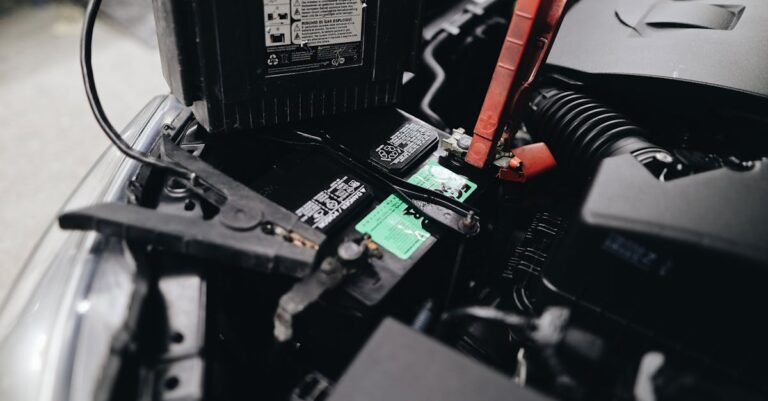Table of Contents
- Hybrid Cars Explained: How They Work
- What Exactly Is a Hybrid Car?
- The Core Components: What Makes a Hybrid Tick?
- How Hybrid Cars Drive: The Different Modes Explained
- Types of Hybrid Systems: Not All Hybrids Are Created Equal
- Busting Common Hybrid Myths
- The Benefits: Why Go Hybrid?
- Are There Any Downsides?
- The Future of Hybrid Technology
- Conclusion: Are Hybrid Cars the Right Choice for You?
- Frequently Asked Questions (FAQs)
Hybrid Cars Explained: How They Work
Ever found yourself stuck in traffic, watching your fuel gauge dip lower and lower, thinking, “There has to be a better way?” Well, you’re not alone! For years, engineers have been tinkering away, looking for solutions that blend efficiency with practicality. Enter the hybrid car – a fascinating piece of technology that promises better fuel economy and lower emissions without asking you to completely ditch the gas station. But how exactly do these clever vehicles manage to sip fuel while still getting you where you need to go? Let’s pop the hood, figuratively speaking, and dive into the world of hybrid cars.
What Exactly Is a Hybrid Car?
Okay, let’s start with the basics. At its heart, a hybrid car is simply a vehicle that uses more than one source of power to move. Think of it like having two different tools for the same job. In the vast majority of cases we see on the road today, this means combining a traditional gasoline internal combustion engine (ICE) with an electric motor (or sometimes more than one!).
The Best of Both Worlds: Gas and Electric Power
Why the combo, you ask? It’s all about playing to strengths. Gasoline engines are pretty great at providing sustained power for long distances and high speeds, plus refueling is quick and easy thanks to our existing gas station network. Electric motors, on the other hand, are incredibly efficient, especially at lower speeds and during stop and go traffic. They provide instant torque (that zippy feeling when you accelerate) and produce zero tailpipe emissions while running on electricity alone. A hybrid car cleverly merges these two systems, using sophisticated computer controls to decide which power source (or combination of both) is best for any given driving situation. It’s like having a versatile multi tool instead of just a single screwdriver – you’ve got options for different tasks!
Why Choose a Hybrid? A Quick Look at the Appeal
The big draw for most people is fuel efficiency. Hybrids generally burn significantly less gasoline than their conventional counterparts, saving you money at the pump and reducing your carbon footprint. They offer a smoother, often quieter ride, especially when running solely on electric power. Plus, for many drivers, they represent a stepping stone towards fully electric vehicles (EVs) without the “range anxiety” – the fear of running out of battery charge far from a charging station – since the gasoline engine is always there as a backup. It’s a practical compromise that makes a lot of sense for a lot of people.
The Core Components: What Makes a Hybrid Tick?
To truly understand how hybrids work their magic, we need to look at the key players under the hood (and sometimes under the floor!). It’s more than just slapping an electric motor next to a gas engine; it’s a carefully orchestrated system.
The Trusty Gasoline Engine
This is the component you’re probably most familiar with. It’s similar to the engine found in conventional cars, burning gasoline to create power. However, in many hybrids, the gasoline engine can be smaller and optimized for efficiency rather than peak power, because the electric motor is there to help out during demanding situations like hard acceleration or climbing hills. It doesn’t always have to do all the heavy lifting alone.
The Electric Motor: Silent Power
This is the electric heart of the hybrid. It draws power from the battery pack to turn the wheels. What’s really cool is that in most hybrid designs, this motor can also act as a generator. When you slow down or brake, the motor reverses its function, capturing kinetic energy (the energy of motion) that would normally be lost as heat through traditional brakes, and uses it to recharge the battery. We’ll talk more about this nifty trick, called regenerative braking, later.
The High-Voltage Battery Pack: Storing the Juice
Unlike the small 12 volt battery that starts a regular car, hybrids have a much larger, high voltage battery pack. This is typically a Nickel Metal Hydride (NiMH) or, more commonly now, a Lithium Ion (Li ion) battery. Think of it as the fuel tank for the electric motor. It stores the electricity generated by the engine (via the generator) and captured during regenerative braking. Its capacity determines how far the car can travel on electric power alone (if it’s designed to do so) and how much assistance it can provide to the gasoline engine.
The Generator: Making Electricity on the Go
While the electric motor often doubles as a generator during braking, many hybrid systems also include a separate generator. This component is typically driven by the gasoline engine and its primary job is to produce electricity to recharge the high voltage battery pack or directly power the electric motor. It ensures the battery stays charged even if you’re not braking frequently.
The Power Split Device/Transmission: The Brains of the Operation
This is arguably the most complex and ingenious part of many hybrid systems, especially the “series parallel” types pioneered by Toyota. It’s much more than just a standard transmission. This sophisticated gearbox, often using a planetary gearset, acts like a traffic controller for power. It seamlessly blends the power from the gasoline engine and the electric motor(s), decides how much power goes to the wheels, and determines how much power (if any) goes to the generator to charge the battery. It constantly adjusts the mix to maximize efficiency based on how you’re driving.
How Hybrid Cars Drive: The Different Modes Explained
So, you’ve got all these components working together. But what does that actually feel like behind the wheel? How does the car decide what to do? It’s constantly juggling power sources, but it usually boils down to a few key modes:
Starting Up & Low Speed Cruising (EV Mode)
When you first start up many full hybrids, you might notice… nothing. That’s because they often start in pure Electric Vehicle (EV) mode, using only the battery and electric motor. This is perfect for pulling out of your driveway, navigating parking lots, or cruising through slow city traffic. It’s silent, uses zero gasoline, and produces no emissions. The car will stay in this mode as long as the battery has enough charge and your power demands are low.
Acceleration & Heavy Load: When Both Engines Work Together
Need to merge onto the highway or climb a steep hill? Mash the accelerator, and the car’s computer says, “Okay, time for backup!” The gasoline engine seamlessly kicks in to provide extra power, working alongside the electric motor. This combined effort gives you the acceleration you need without overly straining a potentially downsized gasoline engine. It’s teamwork making the dream work (or, in this case, the car accelerate quickly).
Cruising at Higher Speeds: Efficient Gas Power
Once you’re cruising along at a steady highway speed, the gasoline engine is often the most efficient power source. In this mode, the engine will likely be doing most of the work driving the wheels. However, the system is still smart. If there’s excess power being produced, the engine might also turn the generator to top off the battery. If you need a slight boost, the electric motor might quietly chip in for brief periods.
Deceleration & Braking: Capturing Lost Energy (Regenerative Braking)
This is where hybrids really shine in efficiency, especially in stop and go driving. When you lift your foot off the accelerator or press the brake pedal, the electric motor flips its role and becomes a generator. The resistance created by this generation process helps slow the car down, similar to engine braking in a conventional car. Instead of wasting the car’s kinetic energy as heat through friction brakes (though hybrids still have those for harder stops!), that energy is captured and sent back to recharge the battery. It’s like getting free fuel every time you slow down! This is a key reason why hybrids often achieve their best fuel economy figures in city driving, unlike traditional cars.
Types of Hybrid Systems: Not All Hybrids Are Created Equal
While the core concept is the same (gas + electric), automakers have developed different ways to combine these power sources. Understanding these distinctions can help you figure out which type might best suit your needs.
Parallel Hybrids: The Most Common Type
In a parallel hybrid system, both the gasoline engine and the electric motor can directly power the wheels, either independently or together. They are connected to the transmission (often via that clever power split device). This is the most common setup found in cars like the Toyota Prius, Ford Escape Hybrid, and many others. It offers a good balance of efficiency and performance across various driving conditions.
Series Hybrids: An Electric Car with a Gas Generator?
Imagine an electric car where the wheels are only ever driven by the electric motor. Now, add a small gasoline engine whose sole job is to run a generator that charges the battery or provides power to the motor when the battery is low. That’s a series hybrid! The gasoline engine never directly drives the wheels. This setup, sometimes called an Extended Range Electric Vehicle (EREV) like the original Chevrolet Volt (in some modes) or BMW i3 with Range Extender, provides a driving experience very similar to an EV, but with the safety net of a gasoline generator to eliminate range anxiety. They are less common than parallel hybrids.
Plug In Hybrids (PHEVs): Getting Serious About Electric Range
Plug In Hybrid Electric Vehicles, or PHEVs, take the hybrid concept a step further. They have much larger battery packs than standard hybrids, allowing them to travel a significant distance (often 20 to 50 miles or more) on purely electric power. As the name suggests, you can plug these vehicles into an electrical outlet or charging station to recharge the battery, just like a full EV. Once the electric range is depleted, the car seamlessly switches to operate like a regular parallel hybrid, using the gasoline engine and regenerative braking. PHEVs offer the potential for mostly electric commuting for many people, while still having the long range capability of a gasoline car for road trips. Think of them as bridging the gap between traditional hybrids and full EVs.
Busting Common Hybrid Myths
Hybrids have been around for a while now, but some misconceptions still linger. Let’s clear up a few common ones.
Myth 1: You Need to Plug Them In (Mostly False!)
This is probably the biggest confusion. Standard hybrid cars (like the classic Prius) do not need to be plugged in. Ever. They generate their own electricity through the gasoline engine and regenerative braking. Only Plug In Hybrids (PHEVs) have the capability and requirement to be plugged in to maximize their electric driving range.
Myth 2: They Are Slow and Underpowered
Early hybrids might have prioritized economy over performance, but that’s largely changed. The instant torque from the electric motor actually makes many modern hybrids feel quite peppy off the line. When the gas engine and electric motor work together, they can provide surprisingly strong acceleration, often comparable to or even better than similar sized conventional cars. Plus, performance oriented hybrids definitely exist!
Myth 3: Battery Replacement is Exorbitantly Expensive
Worries about battery life and replacement cost were common early on. However, hybrid batteries are designed to last a long time – often the lifetime of the vehicle. Manufacturers typically offer long warranties on hybrid components, often 8 years/100,000 miles or even longer in some states. While replacement out of warranty isn’t cheap, costs have come down significantly, and battery failures are much rarer than many people fear. Furthermore, reconditioning or using refurbished battery packs can be more affordable options.
The Benefits: Why Go Hybrid?
We’ve touched on some advantages, but let’s consolidate the main reasons why drivers are increasingly choosing hybrids.
Saving Money at the Pump: Fuel Efficiency Champions
This is the headline benefit. By using electricity for low speed driving and capturing energy during braking, hybrids significantly reduce gasoline consumption compared to conventional cars of similar size and capability. This translates directly into lower fuel bills and fewer trips to the gas station. Ka ching!
Kinder to the Planet: Reduced Emissions
Burning less fuel means producing fewer greenhouse gases (like CO2) and other harmful pollutants. Driving in EV mode produces zero tailpipe emissions. While they aren’t zero emission vehicles overall (unless running purely on electricity generated from renewable sources in a PHEV), hybrids represent a significant step towards cleaner transportation compared to traditional gasoline cars.
A Smooth and Quiet Ride
The ability to run silently on electric power, especially at lower speeds, makes for a remarkably quiet and refined driving experience. The transitions between gas and electric power in modern hybrids are often incredibly smooth, sometimes barely noticeable. This quiet operation can make commuting and city driving much more pleasant.
Are There Any Downsides?
Of course, no technology is perfect. What are the potential drawbacks of hybrid ownership?
- Higher Purchase Price: Hybrids typically cost more upfront than their non hybrid counterparts due to the added complexity and components like the battery and electric motor. However, fuel savings over time can often offset this initial cost.
- Complexity and Potential Repair Costs: While generally reliable, the complex interplay of two powertrains means there are more components that could potentially require repair down the line, and specialized knowledge might be needed.
- Battery Degradation/Replacement (Long Term): While designed for longevity, batteries do degrade over time, eventually losing some capacity. As mentioned, replacement can be costly if it falls outside the warranty period.
- Weight: The extra components (battery, motors) add weight, which can slightly impact handling dynamics compared to a lighter conventional car, though engineers work hard to minimize this.
- Less Engaging for Some Drivers?: Some driving enthusiasts might find the seamless, often CVT based transmissions and focus on efficiency less engaging than a traditional car with a manual or sporty automatic transmission.
It’s about weighing these factors against the significant benefits.
The Future of Hybrid Technology
Are hybrids just a temporary stepping stone on the way to full electrification? Maybe, but they likely have a significant role to play for years, even decades, to come. Technology continues to improve: batteries are becoming more energy dense and cheaper, electric motors more powerful and efficient, and control systems smarter. We’re seeing more diverse applications, from mild hybrids (providing small boosts) in everyday cars to high performance hybrids in supercars. Plug in hybrids, in particular, offer a compelling blend of electric commuting and long range flexibility that suits many lifestyles. As charging infrastructure develops and battery tech evolves, the balance might shift further towards electricity, but the hybrid’s ability to bridge the gap ensures its relevance for the foreseeable future.
Conclusion: Are Hybrid Cars the Right Choice for You?
Hybrid cars represent a clever and effective way to reduce fuel consumption and emissions without demanding major changes to driving habits or causing range anxiety. By intelligently combining a gasoline engine with an electric motor and battery, they optimize efficiency across various driving conditions, particularly shining in city traffic thanks to regenerative braking and EV mode operation. While they command a price premium initially and involve complex technology, the long term fuel savings, smoother ride, and environmental benefits make them a compelling option for many drivers. Whether it’s a standard hybrid, a series hybrid, or a plug in model, understanding how they work reveals a fascinating blend of engineering aimed at making our drives more efficient and sustainable. If you’re looking for significant fuel savings and a reduced environmental impact without going fully electric just yet, a hybrid might just be the perfect fit for your garage.
Frequently Asked Questions (FAQs)
FAQ 1: Do hybrid cars need special maintenance?
Generally, no. Hybrid cars require the same routine maintenance as conventional cars, like oil changes, tire rotations, and brake checks. The gasoline engine needs regular service. While the hybrid specific components (battery, motor, electronics) are designed to be low maintenance, brake pads often last longer due to regenerative braking doing much of the initial slowing. Some technicians might need specialized training for certain hybrid system repairs, but basic upkeep is very similar.
FAQ 2: How long do hybrid batteries usually last?
Hybrid batteries are built to last a long time, often 100,000 to 150,000 miles or more. Many manufacturers offer warranties covering the hybrid battery for 8 years/100,000 miles or even 10 years/150,000 miles in states following California emissions standards. While they do degrade slowly over time, outright failure within the typical ownership period is uncommon.
FAQ 3: Are hybrid cars better for the environment than regular gas cars?
Yes, overall. By burning less gasoline, hybrids produce fewer greenhouse gas emissions (like CO2) and smog forming pollutants over their lifetime compared to equivalent conventional gasoline cars. While battery production has an environmental impact, studies consistently show that the reduced emissions during driving lead to a net environmental benefit over the vehicle’s life cycle.
FAQ 4: Can I drive a hybrid car if the high voltage battery runs out?
This depends on the type and specific situation. In a standard hybrid, the car manages the battery charge itself – it won’t let it completely “run out” in a way that stops the car, as the gasoline engine can always charge it. If the high voltage battery were to fail entirely (which is rare), the car likely wouldn’t operate. In a Plug In Hybrid (PHEV), if you deplete the “plug in” electric range, the car simply switches over to operate like a normal hybrid using the gasoline engine. You can continue driving as long as you have gas.
FAQ 5: What’s the difference between a mild hybrid and a full hybrid?
A full hybrid (like a Toyota Prius) can drive the vehicle using only electric power for short distances, using gasoline power alone, or a combination of both. The electric motor is powerful enough to propel the car independently. A mild hybrid uses a smaller electric motor/generator that typically cannot power the car on its own. Its main functions are to assist the gasoline engine during acceleration (providing a small boost for better fuel economy or performance), enable smoother engine start/stop functionality, and recapture some energy during braking. Mild hybrids offer smaller fuel economy improvements compared to full hybrids.









